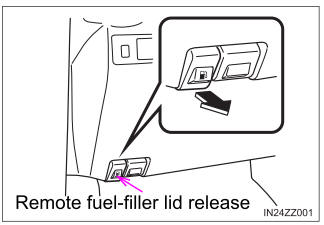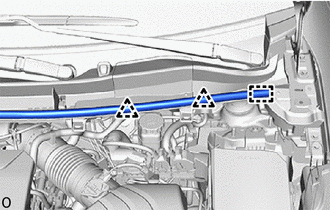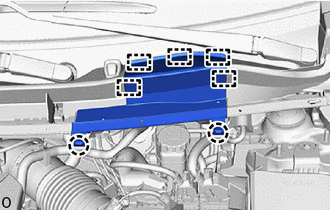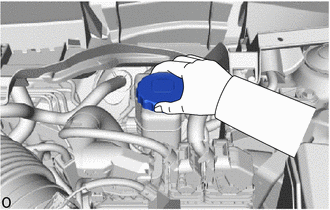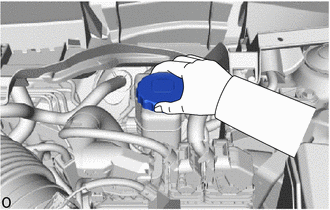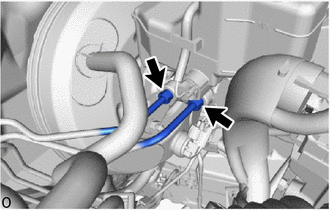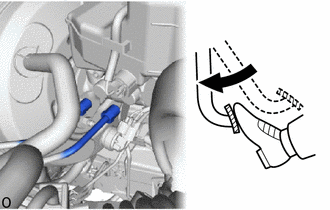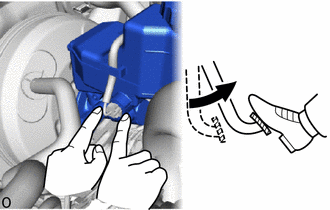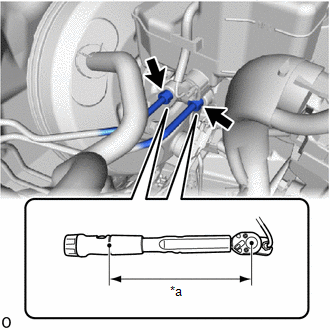Toyota Yaris: Brake Fluid / Bleeding
BLEEDING
CAUTION / NOTICE / HINT
NOTICE:
- Move the shift lever to P and apply the parking brake before bleeding the brakes.
- Add brake fluid to keep the level between the MIN and MAX lines of the reservoir while bleeding the brakes.
- If brake fluid leaks onto any painted surface, immediately wash it off.
- Do not operate the brake actuator assembly while air is in the brake system or in the brake master cylinder sub-assembly. Doing so may cause air to enter the brake actuator assembly.
- If bleeding the brake actuator assembly is difficult due to air in the brake actuator assembly, replace it with a new one.
-
When bleeding air, select the suitable procedure listed below.
Replaced/Installed Item
Work Procedure
Flexible hose (front/rear)
Bleed brake line
Front disc brake cylinder assembly
Rear disc brake cylinder assembly
Brake actuator assembly
Bleed brake system
Brake master cylinder sub-assembly
Brake master cylinder reservoir sub-assembly
Brake booster assembly
HINT:
If any work is performed on the brake system or if air in the brake lines is suspected, bleed the air from the brake system.
PROCEDURE
1. BLEED BRAKE LINE
(a) Remove the center cowl top ventilator louver.
| (1) Disengage the 2 clips and hook to separate the hood to cowl top seal. |
|
| (2) Disengage the 2 claws and 5 guides to remove the center cowl top ventilator louver from the cowl top ventilator louver sub-assembly. |
|
| (b) Remove the brake master cylinder reservoir filler cap assembly. |
|
(c) Add brake fluid to keep the level between the MIN and MAX lines of the reservoir while bleeding the brakes.
Brake Fluid:
"TOYOTA GENUINE BRAKE FLUID DOT4, CLASS6"*, FMVSS No.116 DOT4 or SAE J1704LV*
*: If a fluid type with "TOYOTA GENUINE BRAKE FLUID DOT4, CLASS6", FMVSS No.116 DOT4 or SAE J1704LV is not available, fluid type with TOYOTA GENUINE BRAKE FLUID DOT3, FMVSS No.116 DOT3 or SAE J1703 may be used with no detriment to brake durability.
NOTICE:
- Make sure that there is sufficient brake fluid in the reservoir.
- Do not remove the filter from the brake master cylinder reservoir assembly and be sure to fill the brake master cylinder reservoir assembly with new brake fluid to avoid any potential contamination of the brake system. Contamination, for example by dirt particles or mineral oil, could lead to functional brake problems.
(d) Remove the bleeder plug cap.
(e) Connect a vinyl tube to the bleeder plug.
(f) Depress the brake pedal several times, and then loosen the bleeder plug with the pedal depressed.*1
(g) When fluid stops coming out, tighten the bleeder plug and release the brake pedal.*2
(h) Repeat steps *1 and *2 until all the air in the brake fluid is completely bled out and new brake fluid comes out.
(i) Tighten the bleeder plug completely.
Torque:
Front Disc Brake Bleeder Plug: 10.8 N*m (110 kgf*cm, 8 ft.*lbf)
Rear Disc Brake Bleeder Plug: 8.4 N*m (86 kgf*cm, 74 in.*lbf)
(j) Install the bleeder plug cap.
(k) Repeat the above steps to bleed the brake fluid of the brake lines for each wheel.
(l) Inspect for brake fluid leaks.
(m) Inspect the brake fluid level in the reservoir.
Click here

(n) Install the brake master cylinder reservoir filler cap assembly.
(o) Install the center cowl top ventilator louver.
(1) Engage the 5 guides and 2 claws to install the center cowl top ventilator louver to the cowl top ventilator louver sub-assembly.
(2) Engage the 2 clips and hook to install the hood to cowl top seal.
2. BLEED BRAKE SYSTEM
CAUTION:
If air is bleed without using the GTS, damage or accidents may result. Therefore, always use the GTS when bleeding air.
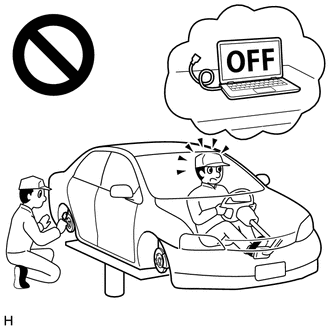
NOTICE:
- To prevent brake fluid from damaging painted surfaces, cover any surrounding parts with a piece of cloth.
- Be sure to clean your hands before bleeding the master cylinder to avoid any potential contamination of the brake system. Contamination, for example by dirt particles or mineral oil, could lead to functional brake problems.
(a) Remove the windshield wiper motor and link assembly.
Click here

(b) Remove the front No. 1 ventilator seal.
Click here

(c) Remove the water guard plate RH.
Click here

(d) Remove the outer cowl top panel sub-assembly.
Click here

| (e) Remove the brake master cylinder reservoir filler cap assembly. |
|
(f) Add brake fluid to keep the level between the MIN and MAX lines of the reservoir while bleeding the brakes.
Brake Fluid:
"TOYOTA GENUINE BRAKE FLUID DOT4, CLASS6"*, FMVSS No.116 DOT4 or SAE J1704LV*
*: If a fluid type with "TOYOTA GENUINE BRAKE FLUID DOT4, CLASS6", FMVSS No.116 DOT4 or SAE J1704LV is not available, fluid type with TOYOTA GENUINE BRAKE FLUID DOT3, FMVSS No.116 DOT3 or SAE J1703 may be used with no detriment to brake durability.
NOTICE:
- Make sure that there is sufficient brake fluid in the reservoir.
- Do not remove the filter from the brake master cylinder reservoir assembly and be sure to fill the brake master cylinder reservoir assembly with new brake fluid to avoid any potential contamination of the brake system. Contamination, for example by dirt particles or mineral oil, could lead to functional brake problems.
| (g) Using a union nut wrench, disconnect the 2 brake lines from the brake master cylinder sub-assembly. NOTICE:
|
|
| (h) Slowly depress the brake pedal and hold it.*1 |
|
| (i) Cover the 2 outer holes with fingers and release the brake pedal.*2 |
|
(j) Repeat steps *1 and *2, 3 or 4 times.
| (k) Using a union nut wrench, connect the 2 brake lines to the brake master cylinder sub-assembly. Torque: Specified tightening torque : 19.5 N·m {199 kgf·cm, 14 ft·lbf} NOTICE:
HINT:
|
|
(l) Remove the bleeder plug cap.
(m) Connect a vinyl tube to the bleeder plug.
(n) Depress the brake pedal several times, and then loosen the bleeder plug with the pedal depressed.*1
(o) When fluid stops coming out, tighten the bleeder plug and release the brake pedal.*2
(p) Repeat steps *1 and *2 until all the air in the brake fluid is completely bled out and new brake fluid comes out.
(q) Tighten the bleeder plug completely.
Torque:
Front Disc Brake Bleeder Plug: 10.8 N*m (110 kgf*cm, 8 ft.*lbf)
Rear Disc Brake Bleeder Plug: 8.4 N*m (86 kgf*cm, 74 in.*lbf)
(r) Install the bleeder plug cap.
(s) Repeat the above steps to bleed the brake fluid of the brake lines for each wheel.
(t) Depress the brake pedal more than 20 times with the ignition switch off.
(u) Bleed the brake system following the instructions on the GTS.
Chassis > Brake > Utility| Tester Display |
|---|
| Air Bleeding |
NOTICE:
Do not start the engine.
(v) After air bleeding, tighten each bleeder plug while depressing the brake pedal.
Torque:
Front Disc Brake Bleeder Plug: 10.8 N*m (110 kgf*cm, 8 ft.*lbf)
Rear Disc Brake Bleeder Plug: 8.4 N*m (86 kgf*cm, 74 in.*lbf)
(w) Inspect for brake fluid leaks.
(x) Inspect the brake fluid level in the reservoir.
Click here

(y) Install the brake master cylinder reservoir filler cap assembly.
(z) Install the outer cowl top panel sub-assembly.
Click here

(aa) Install the water guard plate RH.
Click here

(ab) Install the front No. 1 ventilator seal.
Click here

(ac) Install the windshield wiper motor and link assembly.
Click here

 On-vehicle Inspection
On-vehicle Inspection
ON-VEHICLE INSPECTION PROCEDURE 1. INSPECT BRAKE FLUID LEVEL IN RESERVOIR (a) Check the fluid level. HINT:
If the brake fluid level is lower than the MIN line, inspect for brake fluid leaks and brake pad wear...
 Brake Line
Brake Line
PrecautionPRECAUTION TROUBLESHOOTING PRECAUTION NOTICE:
Since the brake lines are critical safety related parts, be sure to disassemble and inspect the components if a brake fluid leak is found...
Other information:
Toyota Yaris XP210 (2020-2025) Reapir and Service Manual: Components
C..
Toyota Yaris XP210 (2020-2025) Reapir and Service Manual: Evaporative Emission System Purge Control Valve "A" Circuit Open (P044313)
DESCRIPTION To reduce hydrocarbon (HC) emissions, evaporated fuel from the fuel tank is routed through a charcoal canister to the intake manifold for combustion in the cylinders. The ECM changes the duty signals to the purge VSV (Vacuum Switching Valve for Purge Control) so that the intake amount of hydrocarbon (HC) emissions is appropriate for the driving conditions (engine load, engine speed, vehicle speed, etc...
Categories
- Manuals Home
- Toyota Yaris Owners Manual
- Toyota Yaris Service Manual
- How to use USB mode
- Auto Lock/Unlock Function
- Opening and Closing the Liftgate/Trunk Lid
- New on site
- Most important about car
Refueling
Before refueling, close all the doors, windows, and the liftgate/trunk lid, and switch the ignition OFF.
To open the fuel-filler lid, pull the remote fuel-filler lid release.
